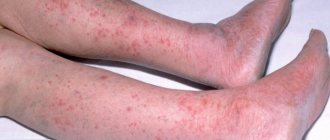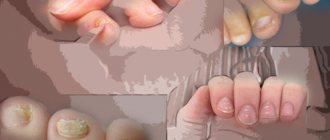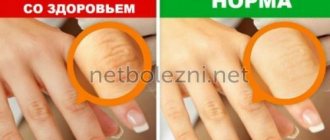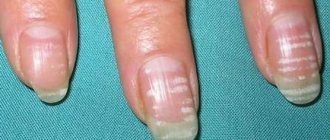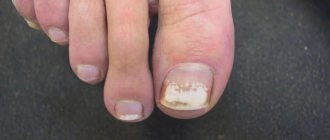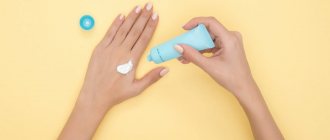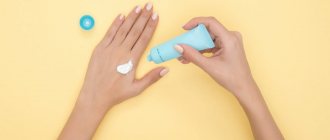The skin around the nails can dry out, peel and crack under the influence of external adverse factors. It becomes more vulnerable to subsequent influences and spoils the well-groomed appearance of hands. Velvet Handles experts will tell you how to remove peeling, moisturize dry skin around your nails and properly care for your hands at home.
Why is the skin around the nails very dry and rough on the hands and feet: the reason
Are your hands dry? Is the skin around the nail plate rough? These are all the reasons for lack of moisture in the skin! In addition, you have too many dead cells around your nails.
What causes excessively rough and dry skin to appear?
There are several factors for this:
- Aggressive household chemicals
- Not very high quality soap
- Skin diseases
- Excess sun
- Pregnancy
- Natural aging processes
Dryness can be of varying intensity and, depending on what caused the problem, treatment should be planned.
IMPORTANT: Depending on your health status, age and lifestyle, the treatment method may vary.
If you want to get rid of discomfort, tenacious hangnails, unkempt-looking hands and dry skin around your nails, you should first consult a dermatologist to diagnose the cause.
The reasons may be:
- PRESENCE OF BAD HABITS. First of all, we are talking about the habit of biting off pieces of hard skin around the nails and the nails themselves.
- WEATHER. For example, climate change or too much exposure to the sun.
- DISEASES. Such as yeast that attacks the fingers (hands and toes), as well as diseases akin to psoriasis and eczema.
- AVITAMINOSIS. Those. lack of certain vitamins in the body. As a result, the skin dries, flakes, cracks and becomes rough.
- ABUNDANCE OF MOISTURE. Extremely long stay in water, plus exposure to soap, detergents, and aggressive chemicals.
How to deal with dry skin around nails?
Dry skin around nails: what vitamins are missing?
Lack of vitamins is the most common problem causing dry skin around fingernails. Not only children, but also adults can face this problem.
How do you know if you have this particular problem?
According to these signs:
- Thinning of the skin
- Skin peeling
- Significant blurred vision at dusk
- Frequent allergies
- Frequent respiratory diseases
- Weak immunity
Treatment consists of consulting a general practitioner and replenishing the vitamin deficiency by correcting nutrition and taking medications.
Dry skin on fingers and nails
Cuticle oil: product features
Cuticle oil softens the skin at the base of the nail, prevents microtrauma, moisturizes and nourishes the epidermis.
Regular use of the product helps maintain well-groomed nails between manicures. The oil is very economical; no more than one drop is needed to treat the cuticle. Options are available in various packages. For nail salons they sell large bottles with dispensers; at home it is more convenient to use mini-bubbles equipped with brushes or pipettes. Pencil-shaped packaging with a tightly screwed cap is suitable for travel. The oil is suitable not only for manicure, but also for pedicure. It can be used daily by choosing your favorite product or alternating formulations from different brands. The price range is very wide. High-quality and effective oils can be purchased at a pharmacy at a very reasonable price; professional salons offer products from well-known brands, which cost significantly more.
All cuticle oils are divided into 3 categories. The first includes natural products of plant origin. This can also include esters that are mixed with base oils to create their own compositions.
The second group combines compositions for nourishing and moisturizing cuticles and nails, manufactured in industrial conditions. Such oils may include natural and synthetic components and contain useful additives: vitamins, amino acids, plant extracts. Most often the composition includes fragrance, dyes and preservatives are often added.
Another category includes oils with added fruit acids, designed to soften the cuticle. After application to the base of the nail, the skin roll becomes elastic, it is easy to move it with a wooden stick, and then cut off the excess with nippers or nail scissors. This type of oil is used no more than 2 times a week; usually the cuticle removal procedure is combined with nail treatment and hand care.
To treat the cuticle, you can use natural base and essential oils.
Dry skin around fingernails and toenails: causes
Yes, if the skin dries around the nails, this causes physical discomfort and aesthetic disturbances. But, you must understand that this sign is simply a SIGNAL from your body. You must accept it and fix the problem.
In addition to your skin, you should also examine the health of your nails. You should only worry when you notice nails:
- Out of shape
- With growths and “humps”
- With stripes
- Too thin
- Too thick
- Yellowed
- Turned blue
- Brittle
In many cases, nails do not “speak” about diseases affecting the fingers, but signal problems within the body:
- THYROID PROBLEMS. Characteristic features: nails are very fragile and often peel.
- DRY OR LOOSE MUSHROOM. The appearance of growths, hardening of the skin, change in color of the plate.
- DEHYDRATION OF THE BODY. It's not just the skin around the nail that dries out. It may peel all over the body. Nails turn white and become streaky.
Dry cuticle, oiled
Dry cuticle: creeping and thin
Dry cuticles are quite common, especially if you have hard water. Dry cuticles make your nails look untidy, and if they are not cared for properly and untimely, they quickly become overgrown with hangnails, and there is often a risk of fungal diseases.
A feature of the thin, dry cuticle is closely spaced capillaries and a large number of pterygium. The main rule when working with such cuticle is to open the pocket well with an orange stick. The optimal manicure in this case would be a hardware manicure and grinding of the burr. With regular manicure, the cuticle will grow less and hangnails will not appear.
Dry and peeling skin around nails: diseases
If you notice that the skin around your nails is drying out and flaking appears on your body and hands, which is sometimes even accompanied by unpleasant itching, this may indicate:
- Climate change
- Lifestyle change
- Age-related changes
- Dry skin
- Excessive sun exposure
- Exposure to chemicals
- Dermatitis
What to do about it:
- Change habits
- Use moisturizers more
- Drink more fluids
- Eliminate potential sources of negative effects on the skin
- Contact a dermatologist
Dry, rough, cracked skin on the cuticle and around the nail may indicate dermatitis.
Dermatitis on the hands:
- Due to allergies . It is characterized by itching, redness of the skin, and unpleasant sensations.
- Seborrhea. Same as psoriasis.
- Atopy. Skin inflammation. Often leads to the appearance of painful cracks, which worsens the course of the disease.
Dry skin and cuticles on fingers
The cuticle and skin around the nails are very dry: methods of treatment, moisturizing
Dry and rough skin around the plates should be treated based on the causes of the problem and the doctor’s diagnosis.
General recommendations for action if the skin around the nails is dry:
- Don't soar your fingers
- Try to keep your fingers in a hot environment (bath, shower, sink) as little as possible.
- Drink enough water per day
- Humidify the room you are in
- Do not injure dry skin even more (biting off hangnails, etc.)
- Moisturize your hands more often with creams, lotions, oils
- Take a multivitamin
Dry skin - aesthetic discomfort
Endocrine diseases. Self-diagnosis
Murzaeva Irina Yurievna
Endocrinologist, Preventive Medicine Doctor
September 3, 2017
Unfortunately, the practice of annual medical examinations and mass disease prevention in kindergartens and schools are gradually becoming a thing of the past. Remember, they used to give fish oil, iodine preparations - Antisturmin, etc. for breakfast. Health magazine taught people all over the country to self-diagnose breast tumors, provide first aid to themselves and others... Times change, not always for the better, but this is a separate topic. The motto of “our intertime” is help yourself.
Today I will tell you how to suspect one or another endocrine disease when examining your own body . Just suspect and consult a doctor, and not start treating yourself!
Information about this mysterious photo is below.
So let's start with SKIN .
It occupies a huge surface area of the body, performs many functions and is the first to respond to changes in the body.
Dryness, peeling (scales) of the skin of the face, torso, arms and legs
- often this is a sign of hypothyroidism (reduced thyroid function), and this is most clearly visible in the dryness and flaking of the elbows, sometimes as a “flour” type, dry elbow with a white coating;
- It can also be a sign of severe dehydration. Take a closer look to see if you have any new wrinkles;
- allergies can always be distinguished - peeling with bright pinpoint rashes and itching;
- peeling and cracking of the fingers - often this is a manifestation of anemia or liver pathology (fatty hepatosis and other diseases);
- But if your feet are dry and flaky, get checked for fungal diseases and diabetes.
What a seemingly insignificant symptom, but so much information.
Acantosis nigricans - I can only write here in Latin, the symptom is extremely important, this is the appearance of dark-colored foci of pigmentation (similar to a tan) in places where clothing rubs: neck, armpits, groin area, under the breasts, on the elbows, a sign of incipient diabetes, or prediabetes. This symptom is also called a sign of insulin resistance (the body’s metabolism of the hormone insulin, which is responsible for the absorption of sugar from food, is disrupted). The symptom is terrible, it also happens in children, and is often a sign of hereditary insulin resistance.
You need to go to an endocrinologist as soon as possible!
Pigmentation is a very broad concept; spots come in different colors and sizes.
A bronze tint of the skin over the entire surface of the body, especially increasing in winter, is a sign of another formidable disease - adrenal insufficiency. It is urgent to donate cortisol and ACTH blood.
Pigmentation with uneven edges, a light brown tint, that appears after childbirth - chloasma, this is a manifestation of a violation of skin nutrition. It is possible that you had iron deficiency anemia during pregnancy; you need to check again to see if there is an iron deficiency. If there are disturbances in the body’s oxidative-antioxidant system (primitively, “a lot of harmful radicals” have accumulated in the body and they damage the skin), it is necessary to resolve the issue of taking alpha-lipoic acid and check liver function.
Pigmentation in women 55+, 60+ is finely dotted, bright brown, which everyone perceives as a tan - a sign of skin aging and a deficiency of sex hormones. It also doesn’t hurt to check for anemia.
Bright brown pigmentation of the lower eyelid can also be a sign of anemia, or, less commonly, adrenal dysfunction.
Pigmentation expressed only on the anterior surface of the skin of the legs (without itching) is often a sign of a “hidden increase” in blood sugar - you need to look for diabetes.
The appearance of bright red spots on the body, often small 2-3 mm - “ruby spots”, a sign of liver dysfunction (fatty hepatosis and other diseases).
Pappules, not acne, on the eyelids, face - they are called xanthomas, these are small wen, it is clear that this is a disorder of fat metabolism and the lipid profile must be checked. They happen even in 7-8 year old children - no one has abolished hereditary dyslipidemia and the child may have cholesterol of 8.0 mmol/l.
INCREASED SWEATING (HYPERHIDROSIS) is a very common symptom.
If the sweating is local - only the hands or only the legs, or only the armpits, this is unlikely to be an endocrine pathology - it is often a dysfunction of the sympathetic nervous system. But sweating all over the body can be a symptom of diffuse toxic goiter, and increased sweating of the scalp is a symptom of vitamin D hypovitaminosis (like rickets).
HAIR
Thinning and hair loss are often the first sign of anemia! This may also be a symptom of hypothyroidism, calcium metabolism disorders and disturbances of other microelements important for hair condition: zinc, selenium, manganese and copper. Hair loss can be a sign of progesterone deficiency (due to cycle disruption in women). And even a decrease in progesterone in men can result in hair loss.
Early gray hair is often the first sign... ANEMIA, sometimes copper deficiency.
Thinning and hair loss at the age of 50+, 60+ is often a deficiency of sex hormones, rather than their excess (previously, in women, this symptom was associated with excess androgens).
But male pattern hair loss in young women, this is hereditary androgenetic alopecia, is often the first symptom of the onset of PCOS (polycystic ovary syndrome).
In men with androgenetic alopecia, everything is simpler - it is often a deficiency of testosterone, and not its excess, as previously thought.
Hair loss in children! – this should be a paradox (a growing child should not have alopecia). This is either a sign of rickets (after 1 year of life, rickets is called osteomalacia), or anemia, or, most often, it is insulin resistance! It is extremely rare, but it happens that it is associated with an autoimmune disease.
Patchy hair loss is a sign of extreme stress, both in children and adults!
In teenage girls, hair loss may be associated with ovarian dysfunction and progesterone deficiency.
Loss of the outer third of the eyebrows is often a sign of iodine deficiency (classic) and hypothyroidism.
Sometimes patients complain about changes in the hair structure, “they were curly and began to straighten sharply” - these are not miracles, this is a violation of the exchange of sex hormones, especially if the woman has been taking COCs (contraceptives) for a long time. In this case, her pituitary gland and ovaries fell asleep, and a deficiency of estrogen and progesterone developed.
And now the most interesting thing is - we take an ordinary centimeter in our hands and begin to measure, what?
- Waist circumference Ladies, a waist circumference of more than 80 cm is incipient obesity. For men – more than 92 cm, “hello obesity.” Children have individual tables for their waist circumference according to height and age; I will not give them here. For the same purpose, pinch yourself under the shoulder blade :D:) If the skin-fat fold in this area is more than 2 cm! This is a sure step towards obesity! When visiting a doctor, it is better to measure the skin-fat fold with a calipermeter; this is a more accurate measurement method.
- Wrist circumference Who said you have a “big bone”? Ladies, wrist circumference: 16-17 cm is the norm. “Thin bone” is less than 16 cm, “large” is more than 17 cm. In men, the norm is 16-20 cm, respectively. But in men it is better not to measure the circumference of the wrist; it is better to determine body composition using bioimpedanceometry - many men have a well-developed or inflated muscle group and it is necessary to look at the real proportions of muscle/fat tissue.
- You can measure the proportion, the ratio of waist circumference / hip circumference. WC/BV more than 0.85 in women and more than 1.0 in men is visceral obesity - obesity of internal organs, indicates the risk of developing metabolic syndrome (obesity with metabolic disorders of both fats and carbohydrates).
You can put the centimeter aside for now;)
LOOKING IN THE MIRROR
Strengthening of nasolabial folds and the appearance of wrinkles outstripping the rate of age-related changes is a sign of a deficiency of sex hormones; it would be good to check with a gynecologist-endocrinologist.
Drooping, swollen upper eyelid - monitor your blood pressure and check your kidneys. In more rare cases, this is a manifestation of hypothyroidism. Swelling and at the same time a change in the shape of the eyes (a look of extreme surprise) is a symptom of dysfunction of the thyroid gland (diffuse - toxic goiter).
Sagging of the oval of the face and the appearance of a double chin are a manifestation of a deficiency of sex hormones and the beginning of a decrease in growth hormone.
NAILS
Ribbed nails, thin and brittle - again everything is primitive, we check for anemia and calcium metabolism disorders. But the flattening and whitening of the nail plates - we check the heart muscle.
So, if all the deficiencies in the body have been eliminated :), but the nails are still thin, the skin is dry and the hair is thinning - it’s time to check the Omega-3 index in the blood, yes, it is the deficiency of healthy omega-3 fats in the body that can be the cause of ongoing skin problems , nails and hair.
The dose of Omega-3 taken will be different for everyone, minimum 2000 mg per day and higher! It is necessary to monitor the omega-3 blood index. That’s why I published this stunning photo of an Eskimo woman at the beginning of the article - gorgeous skin and facial proportions, which means there are no problems with omega-3 and sex hormones:
Finally…..
I really want to talk about the famous “bones” on women’s legs
“they say, I walked around in heels all my youth”;). A woman should walk in heels all her life, and “bunions at the base of the big toe” are a sign of a severe violation of vitamin D metabolism! And, accordingly, weakness of the foot muscles (sarcopenia), so “the bones spread in different directions”, there are no growths there! Get tested for vitamin D deficiency and treat hypovitaminosis D as soon as possible and in large doses.
To be continued…….
The skin around the nails dries, the cuticles on the hands and feet become rough - how to get rid of it: tips
The main thing you should do if your skin around your nails is dry is to try to solve the problem by changing your lifestyle and instilling good habits:
- Wash dishes with gloves
- After water procedures, apply creams and oils to your hands
- In winter, be sure to wear warm gloves and socks (do not let your hands freeze)
- Buy a special humidifier for your home, or place containers of water throughout the house
- Do not use cheap cosmetics, give preference to natural or pharmacy ones
- Make hand oil at home (olive, flaxseed, pumpkin – it doesn’t matter)
Types of cracks
Nail cracking can occur in the middle, along the edges, along or across. There are multiple and single cracks. Assessing their location, length and depth helps determine the reason why nails are cracking. For example, a plate on the hands with a split along its length speaks of psoriasis and blood diseases. Fungal infection causes splitting of the plate along the legs.
Why do nails crack across the middle? As a rule, this is what the consequences of an injury look like due to the inversion of a long nail, improper extension, or excessive filing of the surface of the stratum corneum of the plate.
The skin around the fingernails and toenails hardens and dries: reasons - what to do, how to soften the skin?
Dry skin on the fingers, cuticles and around the nail is very often a cosmetic problem. The treatment must be safe so as not to give you even greater unpleasant consequences.
The best thing to do is turn to “home medicine”. These are the same tips that have been passed down from generation to generation and give effect when the skin mercilessly dries around the nails.
Is the skin around your fingernails and toenails hard and dry? You can also soften the skin using special ointments that are purchased in pharmacies. As a rule, they have a Vaseline base. Cosmetic gloves also have a good effect.
If you are not ready to eliminate dryness with medication, folk methods will help you.
How to save money on manicure?
Do you want to perfectly master the art of manicure from A to Z and never spend 2,000-3,000 rubles in a salon again? Then learn how to do a manicure yourself and save money, time and nerves!
Come to our School for an online course from top teacher Tatyana Svoboda “Manicure for yourself,” which can now be completed for only 499 rubles !
The teacher will tell you all about the technique of applying the coating, removing it, modern designs, how to strengthen your nails, and much more. You will become a real pro and will be able to create your dream nail designs, and, if you wish, monetize your hobby in the future!
Course bonuses:
We give all students a 15% discount on ready-made manicure starter kits, as well as a 5% discount on purchases at ParisNail and 15% on any other online course. Upon completion of the training, you will be issued an electronic certificate of completion of the course.
What to do if the skin around your nails is dry: home remedies and methods
What remedies will help you avoid cases where the skin around your nails dries out:
- A damp towel. Definitely warm. You can wet your fingers with it, relieving unpleasant symptoms. If the problem of dryness is not global, the softened cuticle skin can be cut off with nail scissors.
- Honey. Can relieve inflammation and relieve itching. You should apply masks to your hands for 20 minutes, completely exposing the “problem areas” with honey.
- Aloe. This plant has the natural property of relieving inflammation and softening the skin, as well as fighting infections. Good to use on affected areas or completely all over.
- Bleaching. Oddly enough, a weak bleach solution can have a very positive effect on your hands if there is fungus in them or the nail plates.
- Olive oil. Qualitatively eliminates dryness and gives a pleasant feeling to the skin.
- Nail and skin care. An important component of your health, so try to always keep them clean and beautiful.
What absolutely cannot be done?
- Choose alcohol-based soap or cleanser - alcohol always dries out the skin.
- In winter and summer, before going outside, forget to apply nourishing cream or moisturizer with SPF protection.
- Visit the solarium. At home, after a hot bath, always rinse your face and neck with cold water. It is recommended to wipe your face with ice cubes.
- Wash with soap and hot water to remove makeup. It is necessary to remove makeup with milk and only after that rinse your face with warm water.
What to do if the skin around your nails is dry: reviews
Dry skin around nails: reviews
Daria: “I have a stupid habit of cutting the skin with my fingernail and picking out a piece of dried skin. As a result, the “dry” case ends with wounds that heal for a long time and painfully. I will listen to the advice of the article and regularly anoint my hands with oil!”
Tatyana: “A very good remedy is aloe concentrate. It helps not only heal wounds, but also soften the skin. You can buy it ready-made or simply tear off an aloe leaf from a living plant. Remember that aloe can only be stored in the refrigerator! Plus, the cool liquid is very pleasant to the skin!”
Valeria: “After I started going to the master for a manicure, I noticed that the skin grows around the nail much more intensely and faster than it was before. The master said that this is quite natural, because the cuticle essentially protects the nail, and therefore clearly fulfills its purpose! To prevent this from causing you discomfort, simply lubricate your skin regularly with cuticle oil!”



